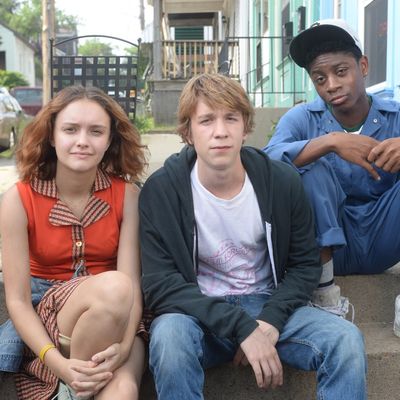
The quirk-jammed tearjerker Me and Earl and the Dying Girl is as clever a piece of meta pandering as you’re likely to see: It’s a movie full of quotations from other movies, it climaxes with a movie-within-a-movie, and it addresses the audience directly from its perch as a movie. Nearly every drop of human experience in it is mediated by movies, not in some Godardian assault on false Hollywood narratives but to flatter an audience too self-consciously hip to swallow this story straight. It’s a remarkably assured con-job — but I’m not sure that the director, Alfonso Gomez-Rejon, and the screenwriter, Jesse Andrews (adapting his own novel), haven’t conned themselves into thinking they’ve captured the feel of modern adolescence better than anyone since Truffaut in The 400 Blows. A poster of Truffaut filming Jean-Pierre Léaud running along a beach makes that theory frighteningly plausible.
The nominal focus is the “doomed friendship” between the narrator, Greg (Thomas Mann), a co-director of comically cheap blockbuster-knockoff videos, and a girl at his high school, Rachel (Olivia Cooke), who has just been diagnosed with leukemia. I’ve put “doomed friendship” in quotation marks because the words are repeatedly used in the intertitles (“Day 8 of the Doomed Friendship,” “Day [Whatever] of the Doomed Friendship”), and so you’re as conscious of the movie’s formal zaniness as you are of the girl’s escalating cancer. “Earl” (RJ Cyler) is Greg’s African American companion, who largely bonds with Rachel over their concern that Greg is scared of acknowledging any and all forms of friendship. Yes, this is another black person who exists in a movie to help the white protagonist grow.
But Rachel is a bit of a prop herself. At first, she and Greg have a spiky relationship: He has only come to visit her because his Mom (Connie Britton) insisted—in true meta fashion — that spending time with a dying girl would be good for his soul. (“You have been given a real opportunity!”) But after Greg and Rachel banter for a while, you see in her eyes that she’s thinking, “Hey, he’s funny,” and a genuine smile spreads across her face. Cooke — a 22-year-old Brit who was a regular on Bates Motel — has an angel-soft face and eyes that grow even bigger as her face becomes more drawn. She spends a lot of time moaning about how ugly she has become, but she’s picture-perfect to the last.
For some reason, Gomez-Rejon (who worked as an assistant to Martin Scorsese before directing episodes of Glee and American Horror Story) is fond of fish-bowl lenses and the occasional Dutch angle. He and Andrews cut to Clay animation scenes of a moose stomping on a chipmunk whenever the high school hottie, Madison (Katherine C. Hughes), approaches him. Nick Offerman seems to be in his own private sitcom as Greg’s dad — the running joke is that he serves Greg and Earl extreme fare of distant cuisines, like East Asian shark—and Molly Shannon is directed to play all her scenes sotted, with a full glass of wine in her hand. The tone is all over the place, but I doubt that Gomez-Rejon would have it any other way. This is not, he might be saying, The Fault in Our Stars — though that movie had its self-conscious meta jokes, too.
It’s obvious that I found much of Me and Earl and the Dying Girl — the sensation of this year’s Sundance Film Festival — appalling, but some of the final scenes snuck past my defenses. The climactic interaction between Rachel and the film that Greg has made for her is so ecstatically weird that it gets points for its audacity. It’s almost inspired. But the coda — an ode to Greg’s self-sacrifice — is unforgivable, a testament to the ego- and power-trip that is the movie’s ultimate reason for being. If it becomes a touchstone for cinephile teens of this generation, you can look forward to a lot more shitty films with filmmaker heroes groping their way towards empathy by staring through a camera lens.


